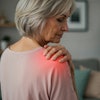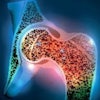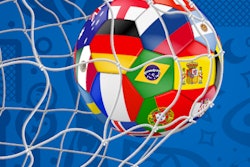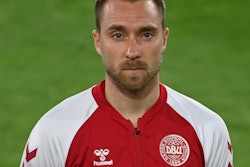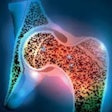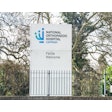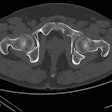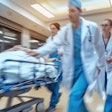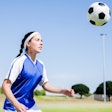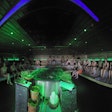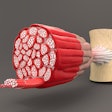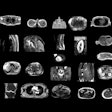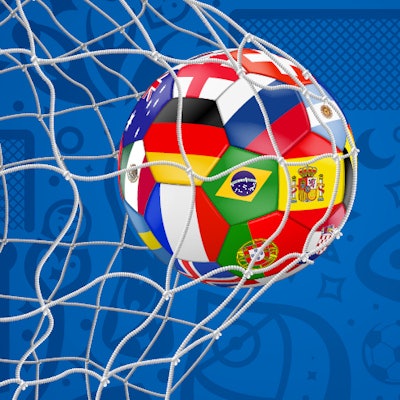
As football fans across the globe gear up for the start of the World Cup in Russia on Thursday, radiologists and other medical teams are putting the finishing touches to their own operations and expertise to ensure optimal diagnosis and treatment for injured players.
A key issue for the organizers, FIFA (Fédération Internationale de Football Association), is the reliability of speedy and appropriate management of any trauma resulting from play. As part of a drive to prime the country's medical staff for such an important event, the government approached the Research and Practice Center of Medical Radiology to create an online and face-to-face training program for radiologists and technicians.
 Up for the cup: Hands-on training for technicians covered MRI protocols and communication skills. All images courtesy of the Research and Practice Center of Medical Radiology.
Up for the cup: Hands-on training for technicians covered MRI protocols and communication skills. All images courtesy of the Research and Practice Center of Medical Radiology."MRI allows for prompt and objective stratification of injuries, and for this reason needs to be available to injured players in every city hosting matches. This means that specialists and technicians in the centers used by FIFA must have excellent skills," noted the center's CEO, Dr. Sergey Morozov, PhD, also professor and chief radiology officer of Moscow. "When I heard about the project from the Ministry of Health in January, I was excited, and then calm because with our years of experience in trauma imaging, this is what we do."
The four-stage program, funded by the government at a cost of 25,000 euros, trained 22 radiologists and 19 MRI technicians from 11 different hospitals across Russia. Local health authorities chose hospitals as the FIFA reference center for the area; then each hospital chose one or two experts from among its staff based on their competence and subspecialties. The trainees include chief specialists, heads of radiology departments, as well as MRI specialists.
The first training stage was the 60-minute entrance test on 20 March to measure the baseline skill level of the participants. Participants could take the test in one of four time windows covering the time zones of the chosen hospitals.
 Radiologists underwent exit testing at the Research and Practice Center of Medical Radiology ahead of the World Cup.
Radiologists underwent exit testing at the Research and Practice Center of Medical Radiology ahead of the World Cup.The test constituted 50 randomly selected questions from a possible 300 questions, based predominantly on MR images. Every radiologist taking part had to have his or her webcam turned on, then the Examus proctoring service checked for any potential cheating. The service remotely takes screenshots to check that participants aren't using additional materials or seeking assistance from third parties.
The Research and Practice Center marked the tests as poor < 55, average 56 to 70, good 71 to 85, or excellent 85 to 100.
The second stage of the testing constituted 10 hours of webinars with two themes presented each week. These internet sessions were well-received by the participants, each webinar scoring a high satisfaction rating, that averaged at 4.8 out of five. Subjects included:
- MR techniques for joint imaging (sequences, parameters, artifacts, etc.)
- MR protocols for lower extremity joints (based on the European Society of Musculoskeletal Radiology's [ESSR] guidelines)
- Sport injuries of muscles and tendons (ARS-syndrome, hamstrings, etc.)
- Knee: osteochondral injuries and menisci
- Knee: ligamentous injuries
- Postsurgical knee trauma
- Ankle: osseous, osteochondral, and ligamentous injuries
- Ankle: impingement syndromes
- Ankle: tendon injuries
- Stress fractures
In a third phase, participants attended a two-day training session at the center on 17 and 18 April. Radiologists discussed cases with musculoskeletal MRI experts, sports traumatologists, and orthopedic surgeons with the sessions covering differential diagnoses, reporting, and treatment strategies.
"My role was in providing specialized information concerning sports injuries: semiotics, treatment, and what exactly radiologists should pay attention to in the case of certain trauma, for example the length of distal stomp in Achilles rupture, and how quickly we should act in the case of locked knee. I also participated in MRI case discussion from the point of view of an orthopedic surgeon," Dr. Musa Maysigov, orthopedic surgeon at the European Clinic of Sports Traumatology and Orthopaedics (ECSTO) in Moscow told AuntMinnieEurope.com.
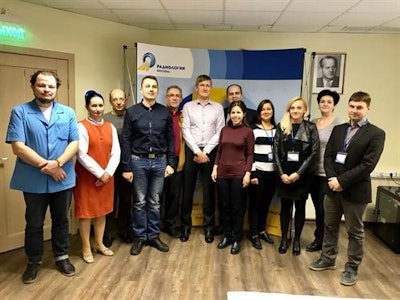 Radiologists who took part in the case interpretation training with Drs. Musa Maysigov (back row, right) and Andrey Uchevatkin (center).
Radiologists who took part in the case interpretation training with Drs. Musa Maysigov (back row, right) and Andrey Uchevatkin (center).For technicians, the practical sessions focused on MRI protocols, data acquisition, and effective communication skills.
According to Dr. Irina Trofimenko, head of the educational department at the Research and Practice center, comparatively few technicians and radiologists speak English, so those involved in the World Cup are learning some basic phrases such as "Please do not move during the exam." She anticipates that other discussions between the radiologists, coaches, and sports doctors will be supported by interpreters.
At the end of the second training day, the radiologists underwent the fourth stage, the exit test, which followed the same format as the entrance test -- 50 randomly selected questions to be answered in 60 minutes. Technicians' scanning skills were evaluated during the workshops.
The exit tests revealed significant improvement according to both Morozov and Trofimenko. At the entry test, seven radiologists were rated as poor, while in the final test this dropped to one.
In the entrance test, nobody was rated as "excellent," but this rose to four people in the exit test.
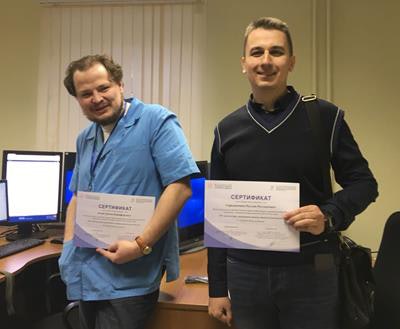 Two candidates proudly display their certificates at the end of the training process.
Two candidates proudly display their certificates at the end of the training process.Dr. Artem Ageev, radiologist and local coordinator of the Ekaterinburg diagnostic unit for the World Cup period, took part in the course as a student, along with other doctors from his radiology unit. He is now in the process of adjusting scanning protocols to fit international diagnostic standards.
He spoke to AuntMinnieEurope.com after the training about how ready the unit feels for dealing with international soccer stars and their various potential injuries.
"We are quite experienced in MRI and after this training we are tuning some of the finer details of obtaining data. The most important subject was standard ESSR protocols for MRI scanning and some specific issues in hip injury diagnostics such as hamstring tears and pubalgia. Standardization will allow us to consult on cases more accurately."
Although from conception to implementation the project has been rather short, the timing was right, according to Morozov. Importantly, imaging professionals' knowledge will be fresh and tournament-ready.
Furthermore, he pointed out the requirements set in the tests were far higher than what will be required for managing most of any injured players.
"There were some very good results even in the entry test, but I am happy there was an overall improvement. The footballers will be in good hands," he added.
During the World Cup, diagnoses will be reported by the reference hospital for the area. For problematic cases, the reports also may be sent to the trauma experts at the Research and Practice Center for a second opinion. Then if the coach considers it necessary, potentially the report will be sent to the player's contact hospital in his team's country of origin. Morozov envisages that 95% of cases will be resolved within Russia.
The government funding covers not only the Research and Practice Center's testing and training of medical staff ahead of the cup, but also ongoing consultation for patient management over the coming weeks, such as the provision of second opinions for player injuries and teleradiology consultation. For future projects he notes that such online training can easily be scaled up to reach even more participants.


